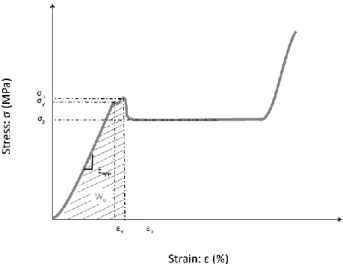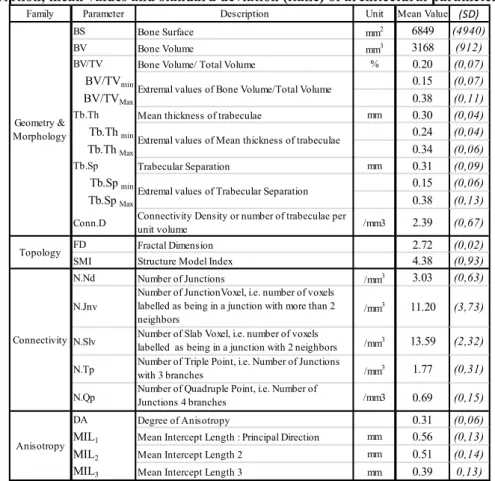Science Arts & Métiers (SAM)
is an open access repository that collects the work of Arts et Métiers Institute of Technology researchers and makes it freely available over the web where possible.
This is an author-deposited version published in: https://sam.ensam.eu Handle ID: .http://hdl.handle.net/10985/8767
To cite this version :
Marianne PROT, Dominique SALETTI, Sébastien LAPORTE, Stéphane PATTOFATTO, Valérie BOUSSON - Correlations between cancellous bone architecture and its dynamic behaviour - In: 4th International Conference on Impact Loading of Lightweight Structures, South Africa, 2014-01-12 - ICILLS - 2014
Any correspondence concerning this service should be sent to the repository Administrator : archiveouverte@ensam.eu
Correlations between cancellous bone architecture
and its dynamic behaviour
M. Prot1*, D. Saletti1, S. Laporte1,S. Pattofatto2, V. Bousson3 1 Arts et Métiers ParisTech, LBM, Paris, France
2 LMT-Cachan (ENS Cachan/CNRS/Université Paris VI/Pres UniversSud Paris), Cachan, France 3 Service de Radiologie Ostéo-Articulaire, Hôpital Lariboisière, Paris, France.
* Corresponding author (email: marianne.prot@ensam.eu)
Abstract
Previous studies showed that in vivo evaluation of the fracture risk of cancellous bone can be assessed by identifying the relationships between its microarchitecture description extracted from clinical imaging and its mechanical properties. The mechanical properties under dynamic loadings (with and without confinement) were obtained and compared to quasi-static ones. The architectural parameters of each specimen were extracted from pQCT images and split into four groups: geometry, topology, connectivity and anisotropy. Results show that architectural parameters are strong determinants of mechanical behaviour for the different applied boundary conditions.
Keywords: Cancellous bone, Dynamic behavior, Confined test, Microstructural Parameters
1. Introduction
Automotive accidents and osteoporosis disease may lead to bone fractures. According to the WHO [1], 2010 marks the transition between two important decades: the decade for bone and ligament and the decade for road safety. In 2004, the WHO reported that in the Americas and Europe, osteoporosis was responsible for about 3 million fractures per year, 1.3 million deaths and 20 to 50 million injuries. Researchers must quantify the risk of injury on living tissues during an impact. Eventually, researchers will work on vulnerable people such as old people or osteoporotic ones driving.
A better understanding of the bone fracture mechanisms could help to improve the design of the safety systems. If the strength of bone mainly depends on the cortical bone, the rupture of the cancellous bone, hosting the bone marrow, could lead to vascular problems or local irreversible damage. The study of the mechanical behavior of the cancellous bone is mostly focused on quasi-static compressive tests [2], for different boundary conditions or with or without bone marrow [3]. Recent experimental works have shown a strain-rate dependency of the cancellous bone mechanical behavior [4] and the influence of the bone marrow for high strain rate loading [5]. Even if studies have demonstrated the link between cancellous bone microarchitecture parameters, bone mineral density and mechanical parameters [6], cancellous bone fracture via architecture characterization has not been fully assessed, especially under high strain rate loading.
The aim of the present study is to identify the correlations between cancellous bone architecture and its dynamic behavior for different boundary conditions.
2. Materials and methods
2.1 Samples
Thirty-two distal segments of bovine femoral bones were used for this study (72 hours post mortem) and frozen at -20°C. A diamond slitting wheel was used to isolate two cylinders of cancellous bone from each frozen bone in the sagittal plane (diameter 41 mm and thickness 14 mm). Specimens were then preserved in vacuum-sealed plastic bags; they were slowly thawed for 12 hours at 5°C and exposed to room temperature (approximately 24°C) prior to mechanical testing.
2.2 Experimental technique and mechanical properties
Samples were divided into three tests series. In the first group, eight specimens were loaded using a quasi-static compression testing Instron machine with a constant nominal strain rate of 0.001 s-1. For the remaining groups, twenty-four specimens underwent dynamic loading using a Nylon Split Hopkinson Pressure Bar system (SHPB). Two different boundary conditions were applied for these dynamic tests: compression tests without confinement for 12 specimens (D, Strain-Rate ca. 1000 s-1) and confined dynamic tests for the 12 remaining specimens (CD, Strain-Rate ca. 1500 s-1). The confined tests were used to limit the radial expansion of the bony structure and the expulsion of bone marrow. Mechanical properties were identified (Figure 1) by an automatic process. The apparent Young Modulus Eapp was identified by fitting the slope of the second third of the linear part of each curve using a least square method. The ultimate parameters were identified at the maximum stress before trabeculae densification while yield parameters enhance the end of the elastic behavior. The plateau stress was identified where the impact energy is absorbed i.e. in a region of the stress-strain curve at nearly constant stress.
Figure 1: Identification of mechanicals parameters
2.3 Microstructure properties
A peripheral quantitative computed tomography technique (pQCT) was used to identify the microstructure properties of each specimen. Eighteen architectural parameters of cancellous bones were selected and computed with BoneJ from the DICOM files. Parameters were divided into four groups: architectural descriptors of geometry and morphology, topology, connectivity and anisotropy. Parameters, units and groups are presented in Table 1.
2.4 Data analysis
The Kruskal-Wallis test was used to assess if there is a difference between the 3 groups of specimens. Mann-Whitney statistical test was performed on mechanical parameters in order to evaluate the influence of strain rate and boundary conditions. Spearman statistical test was used to highlight correlations and inter-correlations between architectural and mechanical parameters. A p-value of 0.05 was chosen as the upper threshold of significance.
3. Results & Discussion
3.1 Mechanical response under high strain rate
Mean values and standard deviations of mechanical parameters are given in Table 1. Data published [7], for bovine cancellous bone solicited to these strain rates set the same magnitude of individual variation.
Apparent Young's modulus values were lower under high strain rates than under quasi-static loadings. To explain this unexpected effect, investigations were performed on about potential errors (elastic wheel point due to local non planarity area of bar / specimen interface, temperature, difference of testing between machine used for high strain rate and low strain rate loading, difficulty to determine Young's modulus with SHPB measurements), but any explanation can be proposed for this result.
Table 1: Mean values and Standard Deviation (italic) of mechanical parameters. D: Dynamic, CD: Confined Dynamic, QS: Quasi-Static.
Since the value of the Mann Whitney test is always less than the threshold of 0.05 (maximum value of 0.006 for comparison between the quasi-static group and the dynamic one and maximum p-value of 0.006 for comparison between the dynamic group and the confined dynamic one), one of the two samples of different strain rate loadings/boundary conditions shows a significant difference.
3.2 Microstructure properties
Mean values and standard deviations of microstructure parameters are given in Table 2. Architectural values have been found relevant to the literature [8].
Table 2: Description, mean values and standard deviation (italic) of architectural parameters.
Since the p-value of Kruskal-Wallis test is always higher (minimum value: 0.44) than the significance level α= 0.05, the null hypothesis, samples coming from the same population, cannot be rejected (minimum risk of rejecting the null hypothesis is 41.5 \% for bone surface study).
3.3 Relationships between mechanical properties and microstructural parameters
Some results regarding the correlation between connectivity and anisotropy parameters and mechanical parameters are reported in Table 3.
E app (MPa) 135 (22) 329 (57) 510 (190) εy(%) 7.68 (1.13) 5.74 (1.07) 4.78 (3.82) εu (%) 8.84 (1.26) 6.88 (1.57) 4.84 (3.82) σy (MPa) 10.93 (2.64) 18.56 (1.09) 12.62 (2.63) σu (MPa) 11.84 (3.43) 20.57 (1.32) 12.64 (2.63) σp(MPa) 8.46 (3.80) 13.78 (2.64) 5.55 (1.39) Wu (J) 8.2 (2.9) 13.00 (2.9) 5.9 (3.6) QS D CD
Family Parameter Description Unit Mean Value (SD)
BS Bone Surface mm2 6849 (4940)
BV Bone Volume mm3 3168 (912)
BV/TV Bone Volume/ Total Volume % 0.20 (0,07)
BV/TVmin 0.15 (0,07)
BV/TVMax 0.38 (0,11)
Tb.Th Mean thickness of trabeculae mm 0.30 (0,04)
Tb.Th min 0.24 (0,04)
Tb.Th Max 0.34 (0,06)
Tb.Sp Trabecular Separation mm 0.31 (0,09)
Tb.Sp min 0.15 (0,06)
Tb.Sp Max 0.38 (0,13)
Conn.D Connectivity Density or number of trabeculae per
unit volume /mm3 2.39 (0,67)
FD Fractal Dimension 2.72 (0,02)
SMI Structure Model Index 4.38 (0,93)
N.Nd Number of Junctions /mm3 3.03 (0,63)
N.Jnv
Number of JunctionVoxel, i.e. number of voxels labelled as being in a junction with more than 2
neighbors /mm
3 11.20 (3,73)
N.Slv Number of Slab Voxel, i.e. number of voxels labelled as being in a junction with 2 neighbors /mm3 13.59 (2,32)
N.Tp Number of Triple Point, i.e. Number of Junctions with 3 branches /mm3 1.77 (0,31)
N.Qp Number of Quadruple Point, i.e. Number of Junctions 4 branches /mm3 0.69 (0,15)
DA Degree of Anisotropy 0.31 (0,06)
MIL1 Mean Intercept Length : Principal Direction mm 0.56 (0,13)
MIL2 Mean Intercept Length 2 mm 0.51 (0,14)
MIL3 Mean Intercept Length 3 mm 0.39 0,13)
Extremal values of Bone Volume/Total Volume
Extremal values of Mean thickness of trabeculae
Extremal values of Trabecular Separation Geometry &
Morphology
Topology
Connectivity
No correlation was identified with regards to Eapp under quasi-static loading. The absence of correlation with DA was also found in the literature [8]. Similar correlations were observed between Eapp for unconfined and confined dynamic loading and MIL1, MIL2, MIL3. Correlations were also observed at different strain rates between the Plateau Strain and the Number of Slab Voxel.
Table 3: Spearman's tests results* for significant correlation i.e. p<0.05 & ***: p<0.0001
D: Dynamic, CD: Confined Dynamic, QS: Quasi-Static.
4. Conclusions
This study examined in what extent the relationship between architectural parameters from clinical-CT and mechanical response parameters at low strain rate (0.001 s-1) can be extrapolated for high strain rate loading (1000 s-1). The compression experiments were performed using two different boundary conditions (confined and non-confined). This work presents a new approach to cancellous bone mechanical prediction under dynamic loading via architectural parameters description: the relative usefulness of architectural parameters has been highlighted with regard to the prediction of mechanical parameters. Our data suggest that a model based on the imaging acquisition method (i.e. architectural description) can be built for the prediction of daily risks or rupture mechanism in the case of a known magnitude trauma such as a car accident.
References
[1] World Health Organization, Department of Violence & Injury Prevention &Disability. Global status report
on road safety, time for action. 2009
[2] V. Kefalas and D. Eftaxiopoulos. Experimental study of cancellous bone under large strains and a constitutive probabilistic model. J Mech Behav Biomed, 2011.
[3] M. Charlebois et al... Confined and unconfined compression tests of human trabecular bone up to very
large strains. J Biomech, 41 (S1), 2008.
[4] A. Pilcher, X. Wang, Z. Kaltz, J. Garrison, G. Niebur, J. Mason, B. Song, M. Cheng and W. Chen. High
strain rate testing of bovine trabecular bone. J Biomed Eng. 132:081012, 2010.
[5] J. Halgrin et al.. On the effect of marrow in the mechanical behavior and crush response of trabecular
bone .J Mech Behav Biomed, 5(1):231-7, 2012.
[6] A. Syahrom. Mechanical and micro-architectural analyses of cancellous bone through experiment and
computer simulation. IFMBE, 2011.
[7] R.M., Guedes et al. 2006. Viscoelastic behaviour and failure of bovine cancellous bone under constant
strain rate. J Biomech, 39 49-60, 2006.
[8] J. Teo et. al. Relationship between CT- intensity, micro-architecture and mechanical properties of porcine
vertebral cancellous bone. Clinical Biomech, 21(3):235-244, 2006.
Nd.Nd N.Nd N.Jnv N.Slv N.Tp N.Qp DA MIL1 MIL2 MIL3
QS D * * * * * * * CD * * * * * QS *** * *** * * *** *** *** D * *** * *** *** *** CD * * *** * * *** *** *** E app σp


